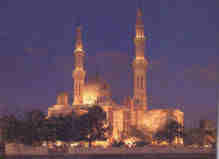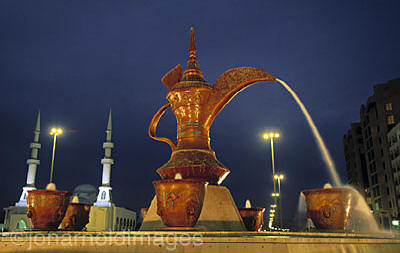|
Abu Dhabi - History
Arabic Abu Zaby town is the capital of Abu Dhabi emirate, one of the
United Arab Emirates and the national capital of that federation. The
town occupies most of a small triangular island of the same name, just
off the Persian Gulf coast and connected to the mainland by a short
bridge. Abu Dhabi was formerly an undeveloped town of only local
importance, but the emirate's oil revenues have enabled it to develop
into a modern city with a fully developed infrastructure.
No settlement existed at Abu Dhabi town before 1761, when the nomadic
tribesmen of the Al bu Falah clan of the Bani Yas, rulers of Abu Dhabi
then as now, settled there mostly because of the discovery of water on
Abu Dhabi Island. They moved their headquarters to this coastal islet
from the inland Liwa oases in 1795. The sheikhdom became a British
protectorate in 1892. |
 |
|
The first post office was established in Abu Dhabi and Das Island on
March 30th, 1963. During this period the same British surcharged stamps,
which were used in Dubai, and Muscat used in Abu Dhabi. In fact, the
Trucial States issue of 1961 have come to be used in Abu Dhabi but due
to the ruler objection to the design of the lower value (seven palm
trees of differing size), the British surcharged stamps were used only.
The first Abu Dhabi definitive was issued on March 30th, 1964.
Through most of the 19th and early 20th centuries, the town, though
capital of one of the chief sheikhdoms of the Trucial Coast, yielded
pride of place in trade and economic importance to Dubai town and ash-Shariqah
town, capitals of neighbouring Trucial sheikhdoms. The pearling industry
that once thrived in Abu Dhabi declined after oil was discovered there
in the early 1960's. The abundant oil revenues have been used for
development and modernization. The city of Abu Dhabi became the
provisional capital of the United Arab Emirates when it was formed in
1971; a new capital on the border between Abu Dhabi and Dubai has been
proposed.
Barely 20 years ago, Abu Dhabi was a tiny settlement surrounded by
desert. Today, Abu Dhabi is a truly cosmopolitan city where people from
almost every country in the world live and work in harmony with the
local citizens. A pragmatic Government making judicious use of oil
wealth has indeed put Abu Dhabi on the international map.
|
Dubai - History
Dubai's heritage is buried deep in the history of Arab civilization.
Settled at least 3000 years ago, Dubai's harbour is said to be one
of the world's oldest seaports. Strong Leadership from the Maktoum
Family Dubai became a Shaikhdom in 1833 when the nomadic Bani Yas
tribe, led by Maktoum bin Buti migrated from Abu Dhabi to settle
there. As Dubai did not have fertile land, fishing, pearling and
trading were prevalent. For over a century Britain's strong presence
in The Gulf helped quell the piratical Qawasim tribes in 1805.
Britain declared Dubai its main Gulf port in the 1870s. In 1890 a
regular ship from Bombay also began. Cheap fares brought merchants,
craftsman and pearlers and by the turn of the century Dubai was The
City of Merchants. After Teheran introduced taxes on its merchants
in 1902, India shifted its trade to Dubai, attracted by the liberal
policies of Shaikh Maktoum Bin Hasher. His son, Saeed, succeeded as
ruler in 1906, accelerating Dubai's growth. |
 |
The Gulf's prosperity received a setback in the 20s from the Japanese
cultured pearl, which wiped the pearling industry. A bleak period in the
30s saw the outbreak of the 2nd World War. Dubai fared better than most
Gulf States through its varied economy.
In 1958 Shaikh Rashid bin Saeed Al Maktoum, both a visionary and a man
of action, well loved and respected focused Dubai's energies on trade.
By the time oil was discovered in Dubai in 1966, it was already poised
to become the Gulf's busiest trading centre.
Oil wealth was poured into improving the standard of living and the
commercial infrastructure, which would secure the future. A flurry of
construction during the 60s-70s produced modern hospitals, schools,
roads, bridges, transport, communications, office buildings, hotels,
parks and recreational facilities. Some of the projects like Port
Rashid, were of staggering dimensions. Completed 1972, it is the largest
deep-water harbour in the world.
In 1971, Britain withdrew and Gulf Shaikhdoms including Dubai, formed
the federation of the United Arab Emirates. Today the UAE has 1.9
million inhabitants, and the wealthier states assist development in the
smaller, less oil-rich states. When Shaikh Rashid died in 1990 his four
sons took up the reins, led by the eldest, Shaikh Maktoum, also
vice-president of the UAE. |